| Slovakia’s War:
Scenario Preview, Part Three
By Mike Bennighof, Ph.D.
August 2019
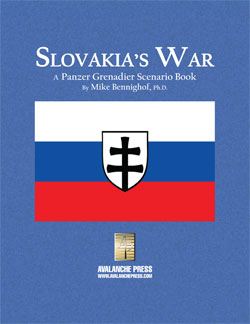 In my newspaper days (if anyone remembers newspapers), I worked for an editor named Bill. All of the reporters were very young, and very excitable. We’d rush into the newsroom with some hot story that we had all to ourselves and Bill would just stare and ask, “Is it exclusive because no one else knows about it, or because no one else wants it?” In my newspaper days (if anyone remembers newspapers), I worked for an editor named Bill. All of the reporters were very young, and very excitable. We’d rush into the newsroom with some hot story that we had all to ourselves and Bill would just stare and ask, “Is it exclusive because no one else knows about it, or because no one else wants it?”
Panzer Grenadier: Slovakia’s War is, as far as I know, an exclusive topic for us. The research was pretty tough, so maybe that’s because no one else has managed to find out enough about the battles of the Slovak Army to build a game about it. Since multiple wargame designers boast online about getting their information from other board and computer games (a source that might just possibly be worse than Wikipedia), I have to think it’s because no one else is crazy enough to publish a game about the Slovak Army.
In our previous two installments, we saw the Slovak Army fight alongside the Germans on the Eastern Front (and behind it). Lack of enthusiasm for the Axis cause, lack of trained officers, poor education levels – all of these contributed to the weak Slovak performance. This time they get to fight the Germans. Let’s have a look.
Scenario Fourteen
Fighting French
21 August 1944
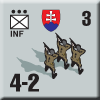 The first open fighting between German and Slovak troops took place near Zilina, a garrison town in northwest Slovakia. The local commander gathered about 1,000 men and some tanks, and a group of French partisans (escapees from German labor camps) and a Slovak partisan group joined him as well. Ordered to block the Vah River valley, they soon came under attack from Battle Group Von Ohlen of the 82nd Reserve Panzer Grenadier Regiment. The first open fighting between German and Slovak troops took place near Zilina, a garrison town in northwest Slovakia. The local commander gathered about 1,000 men and some tanks, and a group of French partisans (escapees from German labor camps) and a Slovak partisan group joined him as well. Ordered to block the Vah River valley, they soon came under attack from Battle Group Von Ohlen of the 82nd Reserve Panzer Grenadier Regiment.
Conclusion
The Slovaks initially did well, holding back the Germans and damaging or destroying four of their tanks. But the Slovak partisans detailed to hold the hilltop on the right flank melted away without offering any resistance, and the Germans exploited this gap. Outflanked, the Slovaks pulled back and called in more regular reinforcements to hold a new line.
Notes
A battalion-sized German motorized group backed by a tank company is trying to force its way through Slovak defenders. The Slovaks have a couple of companies of regular infantry and some tanks, and also some Partisans. The Partisans lose their will to fight as losses mount, which is going to make it tough on the Slovak player.
Scenario Fifteen
Fighting Slovaks
2 September 1944
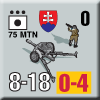 As with other former members of the Axis, Slovak troops fought against the Germans with far greater enthusiasm than they had ever displayed when fighting alongside them. Falling back from the Var valley, the Slovaks received more troops, tanks and most importantly, large-caliber anti-tank guns. The Germans would come to regret having given these to their allies – weapons the Slovaks had never fired at the Soviets – but they had made good their tank losses and picked up a few more. As with other former members of the Axis, Slovak troops fought against the Germans with far greater enthusiasm than they had ever displayed when fighting alongside them. Falling back from the Var valley, the Slovaks received more troops, tanks and most importantly, large-caliber anti-tank guns. The Germans would come to regret having given these to their allies – weapons the Slovaks had never fired at the Soviets – but they had made good their tank losses and picked up a few more.
Conclusion
The Slovaks held their ground this time, but not without serious losses. German Stuka dive-bombers destroyed several artillery batteries, and all of the Slovak tanks fell victim to German tanks and anti-tank guns. Repelled, the Germans pulled back and re-grouped for another try while reinforcements flowed in from Germany, Poland and elsewhere.
Notes
The Slovak force is about as good as a Slovak force gets, with tank, artillery and anti-tank support and reasonable morale. But they have a lot of ground to cover, against a mobile German force that’s more or less their equal.
Scenario Sixteen
Depot Guard
2 September 1944
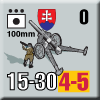 When the Slovaks rose against the Nazis, one of the country’s most important military assets was the huge ammunition depot at Kvetnica. But when the Slovak Army’s two regular infantry divisions were disarmed without a fight, the means to defend it became very sparse. A nearby garrison regiment joined with a partisan unit and a wandering tank company to hold the vital position. When the Slovaks rose against the Nazis, one of the country’s most important military assets was the huge ammunition depot at Kvetnica. But when the Slovak Army’s two regular infantry divisions were disarmed without a fight, the means to defend it became very sparse. A nearby garrison regiment joined with a partisan unit and a wandering tank company to hold the vital position.
Conclusion
The German battle group, part of the 18th “Horst Wessel” SS Panzer Grenadier Division, broke through the Slovak line and occupied the ammunition dump before the Slovaks could do anything to destroy the stockpiles there. Over 40 million rounds of ammunition and more than 800 machine guns fell into German hands, while patriotic Slovak volunteers were being sent away from garrisons and partisan camps because of a lack of weapons.
Notes
The Slovaks are under attack by tank-supported racists; they have a motley array of troops and weapons that does include some tanks and some very good anti-tank guns (and some that are less than inspiring). While Slovak morale is only middling, the aptly-named Horst Wessel Division is no better.
Scenario Seventeen
Fighting Germans
4 September 1944
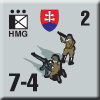 Though the Slovaks had scored one of their few victories of the Second World War, they had lost most of their support weapons in the process while the German force remained more or less intact. The Germans began their renewed attack with a heavy artillery barrage, and then sent their tanks forward in a frontal assault while infantry forces tried to envelop both Slovak flanks. Though the Slovaks had scored one of their few victories of the Second World War, they had lost most of their support weapons in the process while the German force remained more or less intact. The Germans began their renewed attack with a heavy artillery barrage, and then sent their tanks forward in a frontal assault while infantry forces tried to envelop both Slovak flanks.
Conclusion
This time things went much better for the Germans, as the Slovaks had little with which to stop their tanks. The Slovaks at first fell back in good order, but then as the tanks pursued them a rout ensued. Knowing their troops to be ill-trained, the German command pulled back the reins on pursuit before they could become disorganized. The Slovak officers used the respite to restore order in their own ranks and incorporate reinforcements.
Notes
The Slovaks have reasonable numbers and morale, but with just one good anti-tank battery and no artillery support, they’re at a serious disadvantage. Yet neither side has an edge in tanks or morale, so the Slovak Army can still put up a pretty good fight.
Scenario Eighteen
Slovak Revival
5 September 1944
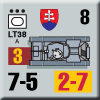 Realizing that this fight might continue for some time, the Germans gathered their mixed bag of small units into the new 178th “Tatra” Panzer Grenadier Division and renewed their attack. The Slovaks continued to gain reinforcements, and every day a few more tanks previously noted as “irreparable” on reports made to central headquarters or the German liaison staff rolled out of the arsenal in Martin. Realizing that this fight might continue for some time, the Germans gathered their mixed bag of small units into the new 178th “Tatra” Panzer Grenadier Division and renewed their attack. The Slovaks continued to gain reinforcements, and every day a few more tanks previously noted as “irreparable” on reports made to central headquarters or the German liaison staff rolled out of the arsenal in Martin.
Conclusion
This time the Slovaks fought with much more determination, and when it became obvious that the German attack had faltered, their tanks launched a counterattack of their own. The tanks met with disaster, moving forward without artillery preparation or infantry support, and German anti-tank guns soon dispatched the Slovak Panzer III’s while the Slovak light tanks somehow escaped a gunnery duel with the German Panzer IV's.
Notes
It’s a large battlefield, which works against the Slovak cause as the Germans are motorized and they are not. There aren’t a lot of Slovak tanks, and they’re out-gunned and out-numbered by the panzers. But the Germans, while they have numbers, aren’t very good outside of their tank support, so the Slovaks have a good chance of stopping them.
And that’s the first half of the Sloval National Rising. Next time, we conclude things with the second half.
Send the Slovaks into battle! Click here to order Slovakia’s War.
Sign up for our newsletter right here. Your info will never be sold or transferred; we'll just use it to update you on new games and new offers.
Mike Bennighof is president of Avalanche Press and holds a doctorate in history from Emory University. A Fulbright Scholar and award-winning journalist, he has published over 100 books, games and articles on historical subjects.
He lives in Birmingham, Alabama with his wife, three children and his dog, Leopold.
|
